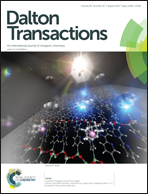Dual-targeting organometallic ruthenium(ii) anticancer complexes bearing EGFR-inhibiting 4-anilinoquinazoline ligands†
Abstract
We have recently demonstrated that complexation with (η6-arene)RuII fragments confers 4-anilinoquinazoline pharmacophores a higher potential for inducing cellular apoptosis while preserving the highly inhibitory activity of 4-anilinoquinazolines against EGFR and the reactivity of the ruthenium centre to 9-ethylguanine (Chem. Commun., 2013, 49, 10224–10226). Reported herein are the synthesis, characterisation and evaluation of the biological activity of a new series of ruthenium(II) complexes of the type [(η6-arene)Ru(N,N-L)Cl]PF6 (arene = p-cymene, benzene, 2-phenylethanol or indane, L = 4-anilinoquinazolines). These organometallic ruthenium complexes undergo fast hydrolysis in aqueous solution. Intriguingly, the ligation of (arene)RuII fragments with 4-anilinoquinazolines not only makes the target complexes excellent EGFR inhibitors, but also confers the complexes high affinity to bind to DNA minor grooves while maintaining their reactivity towards DNA bases, characterising them with dual-targeting properties. Molecular modelling studies reveal that the hydrolysis of these complexes is a favourable process which increases the affinity of the target complexes to bind to EGFR and DNA. In vitro biological activity assays show that most of this group of ruthenium complexes are selectively active inhibiting the EGF-stimulated growth of the HeLa cervical cancer cell line, and the most active complex [(η6-arene)Ru(N,N-L13)Cl]PF6 (4, IC50 = 1.36 μM, L13 = 4-(3′-chloro-4′-fluoroanilino)-6-(2-(2-aminoethyl)aminoethoxy)-7-methoxyquinazoline) is 29-fold more active than its analogue, [(η6-arene)Ru(N,N-ethylenediamine)Cl]PF6, and 21-fold more active than gefitinib, a well-known EGFR inhibitor in use clinically. These results highlight the strong promise to develop highly active ruthenium anticancer complexes by ligation of cytotoxic ruthenium pharmacophores with bioactive organic molecules.


 Please wait while we load your content...
Please wait while we load your content...